Opera window
An opera window is a small fixed window usually behind the rear side window of an automobile.[1] They are typically mounted in the C-pillar of some cars.[2] The design feature was popular during the 1970s and early 1980s that was adopted by domestic U.S. manufacturers most often with a vinyl roof.[2]
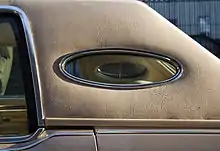
The origin was from around 1915 "opera" vehicles with occasional collapsible seating for extra passengers.[3] The opera window was also a feature on "formal roof" and limousine models with higher than normal roof to accommodate passengers with top hats.[3]
History
.jpg.webp)

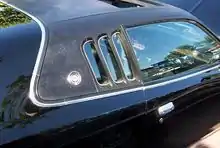

The design element of a distinct, fixed, centered opera window was borrowed from such windows in horse-drawn carriages and used during the classical era of automobile styling. For example, “...the Elcar in 1924 was good looking...and even a fabric top in the style of a brougham with oval opera windows framed by landau bars...[4] Opera windows saw their demise in the 1930s.
Perhaps the most notable return was the "porthole" in the 1956–1957 Ford Thunderbird. It was provided as an option to improve rear-quarter visibility with the removable hardtop in place. “...The hottest thing going was the "porthole" window in the rear side pillar - called "opera windows" that came in during the horse and buggy [era]...[5]
Opera windows began reappearing in the early 1970s in such vehicles as the 1972 Continental Mark IV. Almost all personal luxury cars would adopt-opera windows, usually framed by a vinyl roof.[6] Most often, opera window variants were applied on two-door hardtop or coupé models, spanning all types of vehicles from economy compacts to flagship personal luxury cars, in which latter exploding realm they became “recognition elements” seeking to add a vintage element to their styling.[7] General Motors introduced all-new line of mid-sized "Colonade" models for the 1973 model year. Standard on all the coupes was a fixed triangular rear quarter window while higher trim versions used a rectangular vertical opera window.[8]
In some cars, an additional feature was the so-called opera light that was mounted on the outside of the B-pillar or C-pillar and illuminated when the exterior lights were switched on.
Function
The windows were intended to offset the significant blind spots created by wide C-pillars that were characteristic of many American cars produced at this time.[9] In an age of decreasing dimensions and increasingly common use of non-opening rear side windows on 2-door models, a variety of shapes of rear windows may have helped passengers there to feel somewhat less claustrophobic.
These windows were usually non-functional; however, in the case of the AMC Matador coupe NASCAR racers, the small windows that came with the Barcelona II trim package actually helped to clean up the aerodynamics when such windows were open to the wind under racing conditions.[10]
Examples
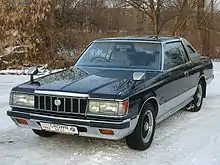
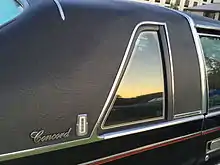
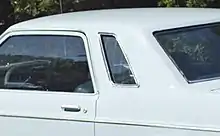
- AMC Concord (1978–1982 coupe, 1980–1983 4-door sedan)[11]
- AMC Eagle coupe, 4-door (1980–1988)[12]
- AMC Matador coupe: D/L Formal Window Package (1974–1975) and Barcelona (1976–1978)[13][14][15][16]
- Buick Regal coupe (1973–1977)
- Buick Riviera (1974–1978)
- Cadillac Coupe de Ville (1974–1979, 1985–1993)
- Cadillac Sedan de Ville (1975–1976)
- Cadillac Eldorado (1971–1978)
- Cadillac Fleetwood Brougham coupe (1980–1985)
- Cadillac Fleetwood coupe (1985–1986, 1989–1992)
- Cadillac Sixty Special coupe (1993)
- Cadillac Fleetwood 75 series (1971–1976, 1985–1987)
- Cadillac Fleetwood limousine (1977–1984)
- Chevrolet Caprice (1974–1976)
- Chevrolet Chevelle coupe (including Malibu and Laguna, 1973–1977)[17]
- Chevrolet Concours coupe (1976–1977)
- Chevrolet Impala (1974–1976)
- Chevrolet Monte Carlo (1973–1977, 1981–1988)
- Chrysler Cordoba (1975–1983)
- Chrysler LeBaron coupe (1977–1986)
- Chrysler Newport (1976–1978)[18]
- Chrysler New Yorker (1974–1978)
- Chrysler TC by Maserati (1989–1991)
- Citroën BX Series 1 (1982-1986)
- Continental Mark IV, V & VI (1972–1983)
- Daihatsu Charade Runabout (G10/20, 1978–1983)
- Dodge 400 (1981–1983)
- Dodge 600 coupe (1984–1986)
- Dodge Aries 2-door (1981–1989)
- Dodge Aspen coupe (1976–1980)
- Dodge Charger (1973–1978)
- Dodge Diplomat coupe (1977–1981)
- Dodge Magnum (1978–1979)
- Dodge Mirada (1980–1983)
- Dodge Monaco coupe (1977–1978)
- Dodge Royal Monaco coupe (1974–1977)
- Ford Elite (1974–1976)
- Ford Granada 2-door (1975–1980)
- Ford Mustang II Ghia (1975–1978)[19]
- Ford LTD, Crown Victoria 2-door (1975–1987)
- Ford LTD II (1977–1979)
- Ford Thunderbird (1956–1957, 1973–1982, 2002–2005)
- Ford Torino 2-door (1974–1976)
- Imperial LeBaron coupe (1974–1975)
- Lincoln Continental (1975–1980)
- Lincoln Continental Mark IV (1972-1976)[20]
- Lincoln Town Car (1981–1997)
- Mazda RX-5 (1975–1980)
- Mercury Cougar (1974–1982)
- Mercury Marquis, Grand Marquis 2-door (1979–1987)
- Mercury Monarch 2-door (1975–1980)[21]
- Mercury Montego 2-door (1974–1976)
- Nissan Silvia S110 series 2-door coupe (1979–1983)
- Oldsmobile 88 (1974–1984)
- Oldsmobile 98 (1974–1987)
- Oldsmobile Cutlass coupe (1973–1977)
- Oldsmobile Cutlass Calais coupe (1981–1984)
- Oldsmobile Cutlass Salon coupe (1985–1988)
- Oldsmobile Cutlass Supreme (1973–1988)
- Oldsmobile Omega coupe (1975–1979)
- Oldsmobile Toronado (1974–1978)
- Pontiac Bonneville (1975–1979)
- Pontiac Catalina (1974–1976)
- Pontiac Grand Am coupe (1973–1977)
- Pontiac Grand Prix (1973–1987)
- Pontiac Grand Ville (1974–1975)
- Pontiac Lemans coupe (1973–1980)[22]
- Pontiac Phoenix coupe (1977–1979)
- Pontiac Sunbird notchback coupe (1976–1980)
- Pontiac Ventura coupe (1975–1979)
- Plymouth Gran Fury (1974–1977)
- Plymouth Fury (1976–1978)
- Plymouth Reliant 2-door (1981–1989)
- Plymouth Volare coupe (1976–1980)
- Toyota Carina Van TA16V/19V (1975–1977)[23] - perhaps the only wagon with opera windows.
- Toyota Crown coupe (1979–1983)[24]
Notes
- "Oxford Dictionary: definition of Opera Window". Lexico Dictionaries. Retrieved 3 September 2020.
- "1975 Cadillac Fleetwood Eldorado". conceptcarz.com. Retrieved 3 September 2020.
- Haajanen, Lennart W. (2017). Illustrated Dictionary of Automobile Body Styles (Second ed.). McFarland. pp. 80, 112. ISBN 9780786499182. Retrieved 3 September 2020.
- Locke, William S. (2000). Elcar and Pratt automobiles: the complete history. McFarland. p. 71. ISBN 9780786409563.
- Szudarek, Robert (2000). The first century of the Detroit Auto Show. Warrendale, PA: Society of Automotive Engineers. p. 210. ISBN 9780768005028.
- Stern, Milton (April 2018). "The Peak of Personal Luxury". Hemmings Classic Car. Retrieved 3 September 2020.
- Herd, Paul; Mueller, Paul (1994). Charger, Road Runner & Super Bee. Motorbooks International. p. 119. ISBN 9780879388447.
- Flory Jr., J. “Kelly” (2012). American Cars, 1973-1980: Every Model, Year by Year. McFarland. p. 22. ISBN 9780786456369. Retrieved 3 September 2020.
- "Dodge Magnum: the briefly made, sporty-style car of the 1970s". www.allpar.com. February 2017. Retrieved 3 September 2020.
- "AMC Matador NASCAR Bullfighter". Archived from the original on 26 October 2009. Retrieved 3 September 2020.
- Cranswick, Marc (2011). The Cars of American Motors: An Illustrated History. McFarland. p. 252. ISBN 9780786485703. Retrieved 10 January 2019.
- Flammang, James M. (1990). Standard catalog of American cars, 1976-1986 (Second ed.). Krause Publications. pp. 12–14. ISBN 9780873411332.
- Auto Editors of Consumer Guide (26 October 2007). "1974-1978 AMC Matador". HowStuffWorks.com. Retrieved 10 January 2019.
- Sikora, Don (10 April 2013). "Review Flashback! 1975 AMC Matador". Consumer Guide. Retrieved 10 January 2019.
- "1976 AMC Full Line brochure". www.oldcarbrochures.com. p. 22. Retrieved 10 January 2019.
- DeMauro, Thomas A. (August 2018). "Majestic Matador - 1977 AMC Matador". Hemmings Classic Car. Retrieved 10 January 2019.
- Stern, Milton (May 2018). "Malibu: Classic Colonnade". Hemmings Classic Car. Retrieved 4 September 2020.
- DeMAuro, Thomas A. (October 2019). "Cultured Chrysler - 1977-'79 Chrysler LeBaron". Hemmings Classic Car. Retrieved 3 September 2020.
- Farr, Donald (2018). Speed Read Mustang: The History, Design and Culture Behind Ford's Original Pony Car. Motorbooks. pp. 50, 67. ISBN 9780760364420. Retrieved 3 September 2020.
- "1976 Continental Mark IV Designer Edition Opera Windows". automotivemileposts.com. Retrieved 3 September 2020.
- Hartford, Bill (October 1977). "Driving the 1978 Fords, Lincolns and Mercurys". Popular Mechanics. 148 (4): 110. Retrieved 10 September 2020.
Two-doors get a gimmicky "Twin-dow," a split opera window.
- Flory, Jr., J. “Kelly” (2012). American Cars, 1973-1980: Every Model, Year by Year. McFarland. p. 542. ISBN 9780786456369. Retrieved 10 September 2020.
choice of vertically louvered rear quarter windows or rear quarter opera window
- カリーナバン 1400ー1600 [Carina Van 1400–1600] (in Japanese), Toyota, December 1975, p. 4, 135741—5012
- "History of the Toyota Crown". Toyota UK. 6 August 2015. Retrieved 3 September 2020.
opera windows were added to the thick C-pillars to enhance rear visibility and give the model a distinctive design feature